What are the differences between English and Japanese?
Japanese and English are very different languages. From grammar rules and sentence formation, to what is implicit and what is explicit and beyond, there are many differences to find. But many of them can be easily understood! In this article, we will look at the differences between English and Japanese, and identify 8 key differences.
1. The English alphabet, the Japanese alphabets
The English alphabet has 26 letters, from A to Z. These can be written in lowercase (abcd…) or upper case (ABCD…). Japanese, on the other hand, has 3 separate writing systems.
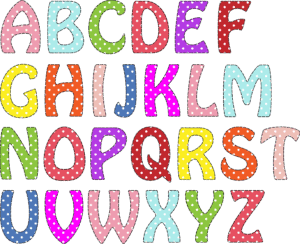
Hiragana
The first Japanese alphabet is called “Hiragana”. There are 46 characters, with an additional 20 extra formations and several other forms that can take this number even higher.
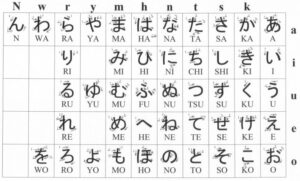
Katakana
THEN, there’s “Katakana”. These are different characters symbolizing the same sounds as Hiragana, so there are the same number of Katakana as Hiragana.

Katakana are used instead of Hiragana for many reasons. For example, to write foreign words in Japanese and to write “loan words.” They are also used for emphasis and to represent onomatopoeia. You can often see katakana used to spell technical and scientific terms, and for names of plants, animals, and minerals. Japanese companies and brands may choose to use Katakana for their name in the same way an English-language brand would use a special font.
Kanji
Finally, there is Kanji. When someone asks how different Japanese is from English, Kanji is probably one of the most common points of discussion.
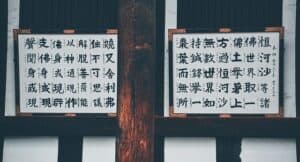
Kanji are characters adopted from Chinese. The average Japanese speaker will know over 2000 kanji, with many knowing anywhere from 3000 to 5000. This is very different from the English 26 letters!
Another important difference is the lack of upper-case letters in Japanese. English uses upper-case letters and capital letters, and has rules for these. Capital letters are used for proper nouns, starting a sentence, title cases… There are many rules that an English-speaker implicitly knows, but are alien to an English learner!
Which brings us to the second point when asking how different is Japanese from English…
2. Reading spellings
When read, Japanese is far easier to pronounce and say as long as you know the alphabets. English spelling, on the other hand, is a mess. Take a look at this excerpt from a famous 1922 poem:
Islington and Isle of Wight,
Housewife, verdict and indict!
Don’t you think so, reader, rather,
Saying lather, bather, father?
Finally: which rimes with “enough,”
Though, through, plough, cough, hough, or tough?
Hiccough has the sound of “cup”……
My advice is—give it up!
https://en.wikisource.org/wiki/Ruize-rijmen/De_Chaos
There are many reasons that English pronunciation and spelling do not match. English has borrowed words from many other languages, especially European languages, but did not change their spelling. This is very different to Japanese, which even has a whole alphabet – Katakana – to distinguish foreign words. Historically, spelling has not changed in English even as pronunciation has.
There are even different spellings in different forms of English. The differences in American and British English spelling are often taught, for example colour and color.

3. Pronunciation/phonemes:
The next is the differences between English and Japanese in relation to the sounds of each language.
Also, one of the differences between English and Japanese is the pronunciation systems. Let’s look at some differences:

Sounds
Japanese has 5 vowel sounds that can be long or short, and 14 basic consonants. English has 20 vowel sounds and 21 consonant sounds. More important than number, however, is that each language has sounds the other does not.
For example, in Japanese, there is no /r/ or /l/ sound. Instead, there is a liquid phoneme, something like a “soft L”. Japanese speakers find it hard to distinguish between and pronounce the English “L” or “R,” and English speakers often do not pronounce the Japanese form correctly.
English speakers, on the other hand, struggle with sounds in Japanese like “fu”or “tsu”. Using the English alphabet, the Japanese “fu” sound is sometimes spelled with an “F,” and sometimes with an “H.” This is because the true sound lies somewhere between.
Really, the only way to really see the differences between these languages is if you use the International Phonetic Alphabet. If you are learning a language, we strongly recommend checking this out!
For more information on the differences between English and Japanese pronunciation, check out our article “why Japanese students have difficulty pronouncing English” .
Pitch accent and intonation
However, Japanese also has a pitch accent. The type of pitch accent is different in different regions of Japan. https://en.wikipedia.org/wiki/Japanese_pitch_accent. In Japanese, the same two syllables can be pronounced with different pitch, changing the meaning of the word. The word “ima” (いま) for example, means now if the first syllable is a higher pitched, and means fence if the second syllable is a higher pitched.
English is generally thought to not have pitch accent, but there are dialects of English that do demonstrate pitch accent . In fact, there are so many varieties of English you will find a lot of different speech patterns!
At the same time, both languages have very different intonation patterns. The best way to learn these is, of course, to listen to native speakers and fluent speakers to hear how the language “flows.”
4. Articles/Particles:
English uses the articles “a,” “an,” and “the.” Japanese, on the other hand, uses particles such as “ha,” “ga,” “no,” “de,” and “ni.” The rules and context for these is very different.
English articles define a noun, marking it as definite or indefinite. Japanese does not do this, and Japanese learners of English often struggle to understand how exactly an article is used to mark a noun.
Japanese particles, on the other hand, mark the relations between words in a phrase. They can alter meaning, nuance, and serve various functions. Learners of Japanese often struggle with Japanese particles, and a slight mistake can change the entire meaning of a sentence!
5. Plurals and Countable/Uncountable Nouns:
Plurals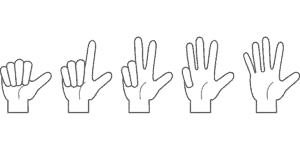
Another important point when asking about the differences between English and Japanese is that Japanese does not pluralise nouns. English does. For example:
One pen, two pens, three pens.
This creates a problem for Japanese learners, especially because English has both countable and uncountable nouns. You can have “two dollars,” but you obviously can’t have “two money.”
This pertains to one of the differences between English and Japanese. English quantifiers have to change if something is countable or uncountable! Especially, the quantifiers “many,” “lots,” and “much” are very different to Japanese, because they change:
I have a lot of money. (I have many money.)
There are many people here. (There are much people here)
I don’t have much money. (I don’t have many money)
Also, Japanese does not pluralise demonstrative pronouns like “this” or “these.” In Japanese, “kore” means both. In Japanese, “sore” means both “that” and “those.”
Counters
Japanese does, however, have over 350 counters. English counts differently.
A Japanese counter must be used with a number. They cannot be used in isolation. For example:
One rat would be counted as “ippiki” – the counter here is “hiki,” which is attached to the number 1.
5 pieces of paper would be counted as “gomai,” where “mai” is the counter.
In English, examples of words similar to Japanese counters are “one carton of milk,” or “20 pieces of paper.” However, these are words that can exist separately from quantity – e.g. “there is a cardboard carton.”
English counters can be very hard for language learners. The difference between one slice of bread and one loaf of bread, for example!
6. Auxiliary verbs:
In English, auxiliary verbs include “be,” “do,” “have,” “can,” “must,” “will” and so on. These are separate words that change the function and meaning of another verb.
Examples of English auxiliary verbs:
I am thinking.
He can think.
I will think about it.
She didn’t think about it.
They should think about it.
In Japanese, 助動詞 (jyodoushi) are auxiliary verbs but they conjugate with the verb they are acting on. Essentially, this means they are not separate words, but “stems” of other verbs.
Examples of Japanese 助動詞 forms:
考えられる。(kangaerareru) I can think.
見させる。(kangaesaseru) It let me see.
考えさせられる。(kangaesaserareru) It made me think.
習いたい。(kangaetai) I want to learn.
考えるべき。(kangaerubeki) I should think.
Furthermore, certain Japanese verbs are commonly used as auxiliary forms with other verbs! Japanese verbs such as 直す、込む、出す、and 切る are verbs by themselves, but can be attached to other verbs to give a new, more expressive meaning.
For example:
切る。(kiru) to cut.
考える。(kangaeru) to think.
考え切る。(kangaekiru) to finish thinking.
走る。(hashiru) to run.
出す。(dasu) to leave.
走り出す。(hashiridasu) to dash away.
7. High context culture vs. low-context culture:
Have you ever considered how much of what you say isn’t actually in your words? How much of what you say is based on what you consider “common sense”?
If a casual acquaintance said to you “we should do lunch sometime,” would you call them immediately to arrange the date, or would you realise sometimes implies they are simply being friendly?
This all has to do with the difference between a high-context culture and a low-context culture. These terms are used to describe “cultures” as small as a church-group or business office, to as wide as national or continent-spanning cultures.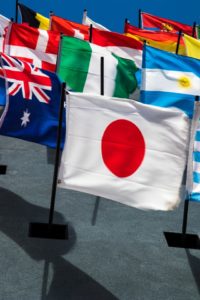
When we ask “how different is Japanese from English?” we have to consider that Japan is often considered a high-context culture.
High-context cultures?
So what do we mean by this? Well, consider Japan. Japan is an island nation with a quite homogeneous culture. While in the modern age Japan is becoming more diverse, and accepting of the diversity within itself, it is still far less diverse than nations such as the USA, UK, or France. Though Japanese-speaking communities exist from Brazil to Hawaii, the vast majority of speakers are in Japan.
This means that, in general, Japanese speakers share social norms, customs, and manners. For example, learners of Japanese may struggle to understand the carefully phrased responses to invitations that, while seeming to be positive, actually are a refusal.
Low-context cultures?
On the other hand, English-speaking nations are often called “low-context cultures,” where meaning is explicit and clearly stated in words.
However, as we saw above, this is also possible in English. The following conversation could easily be in either language:
Why don’t we go out on Friday? 金曜日一緒に遊びに行こうよ。
Ah, well, I’m busy… あ、金曜日はちょっと。。。
In both conversations, a fluent speaker would easily see that the invited person is trying to avoid the invitation entirely. This is a simple example of a far larger issue.
Essentially, the terms “high-context culture” and “low-context culture” should not be considered as an easy-to-define, scientific term, but it is a useful idea. English-speakers and Japanese-speakers have different expectations of what is “normal.” So when asking how different Japanese is from English, we should not only consider grammar and vocabulary, but the unspoken understandings shared between speakers.
8. Personal Pronouns:
English has, basically, 11 personal pronouns when discussing people, as well as “it”. These change for first-person, second-person, or third-person, gender, and whether they are the subject or object in a sentence.
English personal pronouns: I, me, you, she, he, they, them, him, her, we, us.
Japanese personal pronouns do not, however, change between object and subject:
私 Watashi (I/me)
貴方 anata (you)
彼女 kanojo (she/her)
彼 kare (he/him)
彼達・彼女達 karetachi/kanojtachi (they – feminine/masculine)
私達 watashitachi (we/us)
Possessive forms:
This also means that Japanese has no possessive form. In Japanese, just add “no”:
私の Watashino (my)
貴方の anatano (your)
彼女の kanojono (hers)
彼の kareno (his)
The English possessive forms, as you can see, are often totally different spellings and different words!
However, there’s another big difference between Japanese and English! Japanese also has alternative personal pronouns that communicate status.
For example, pronouns that mean “I/me” in English:
私 Watashi (I/me – polite, standard)
私 Watakushi (I/me – extremely polite, formal)
僕 Boku (I/me – casual, humble)
俺 Ore (I/me – casual, coarse)
あたし Atashi (I/me – casual, feminine)
English just doesn’t often use personal pronouns in the same way as Japanese does, to signify status or respect.
8. Word order:
Japanese and English have different rules for word order. Japanese sentences are structured as:
a.Subject
b. Object
c.Verb
This is actually the most common language form among languages.
English, on the other hand, is structured as:
a. Subject
b. Verb
c. Object
Technically, in fact, in English it is not the “subject” that comes first, but the “agent,” but unless you want to study linguistics more this is probably not important now!
However, another thing to remember is that some people think Japanese word order is actually more flexible than English! Particles allow for some flexibility in sentence structure, when used correctly.
Word order of questions
Another big difference between Japanese and English is what happens when you ask questions.
English changes the order of words when forming questions. For example:
You can swim => Can you swim?
I have been to Brazil => Have you been to Brazil?
Japanese does not rearrange word order for questions. All you have to do is add “ka” to the end of a statement:
彼は泳げる => He can swim
彼は泳げるか => Can he swim?
Again, word order inversion can be difficult for Japanese learners of English.
So, how different is Japanese from English?
The answer is, really quite different! These are just some of the many differences between English and Japanese.
However, this doesn’t mean you should worry! Whether you are learning English, or learning Japanese, these differences will become second nature to you with enough practice.
Keep studying, and check out more articles on our website to discover a whole world of language learning!



